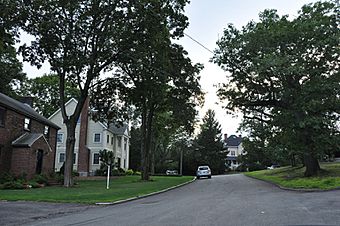West Newton Hill Historic District facts for kids
Quick facts for kids |
|
|
West Newton Hill Historic District
|
|
 |
|
| Location | Roughly bounded by Highland Ave., Lenox, Hampshire, and Chestnut Sts., West Newton, Massachusetts |
|---|---|
| Area | 35.9 acres (14.5 ha) |
| Architect | Taylor, Bertrand |
| Architectural style | Colonial Revival, Queen Anne, Shingle Style |
| MPS | Newton MRA |
| NRHP reference No. | 86001766 |
| Added to NRHP | September 4, 1986 |
The West Newton Hill Historic District is a special neighborhood in West Newton, a village within the city of Newton. It's a "historic district," which means it's a place with many important old buildings. These buildings show how the area grew over time.
This district is full of large, beautiful houses built in the late 1800s. They show how West Newton became a popular place to live, especially for people who used the train to get to work. The neighborhood was added to the National Register of Historic Places in 1986. This is like a list of important historical places in the United States.
Contents
How West Newton Hill Grew
The Boston and Worcester Railroad came through West Newton in 1834. This was a big deal! It helped the area start to grow. Soon after, Chestnut Street was built across the hill. Some houses were built there too.
The Railroad's Impact
Train service got even better in 1843. This made more people want to live in West Newton. In 1849, some people who developed land hired Alexander Wadsworth. He was a landscape designer. He planned out a large area of land on the hill for new homes.
Building Boom on the Hill
About ten houses were built before 1879. But most of the houses in the district were built between 1880 and 1900. The historic district covers about 36 acres. It has 58 houses that are considered "contributing." This means they add to the historical importance of the area. Most of these homes are in the Queen Anne, Shingle, and Colonial Revival styles. Only a few houses were built here after 1936.
Amazing Architecture and Old Homes
The West Newton Hill Historic District is famous for its different house styles. You can see many examples of how homes were built long ago.
Oldest Homes and Unique Styles
One of the oldest houses is at 12 Valentine Street. It's a Greek Revival style house. It was actually moved to its current spot. People think it might even have wood from a very old farmhouse! Another old house is at 128 Chestnut Street. It was built in 1854. It later had some Queen Anne style changes in 1900.
You can also find two cool Second Empire style houses. They are at 152 Chestnut Street and 292 Otis Street. There are also several Italianate style houses.
Queen Anne Houses on Chestnut Street
Chestnut Street has many Queen Anne style houses. For example, 170 Chestnut Street shows off this style. It has an uneven design, different roof shapes, and parts that stick out. These are all common for Queen Anne homes.
Unique House Designs
The houses at 332 and 334 Otis Street are almost mirror images of each other. They have parts that stick out off-center and sloped roofs. The house at 333 Otis Street is very special. It has two small towers called turrets. It also has a porch that wraps around the house with fancy columns. There's even a covered driveway called a porte-cochère. Plus, its carriage house (where horses and carriages were kept) also has a turret, just like the main house!
The Child with Calla Lily Leaves Sculpture
The district also has a beautiful bronze sculpture. It's called Child with Calla Lily Leaves. It was made by an artist named Anne Whitney. This sculpture was first shown in 1893. It was placed in West Newton in 1903. It honors Catherine Porter Lambert, who lived at 128 Chestnut Street.
This sculpture is special because it has an Art Nouveau design. This style was different from most of Anne Whitney's other work. You can find this sculpture in a small community garden. It's on the island where Chestnut, Highland, and Valentine Streets meet.
Protecting History
The West Newton Hill Historic District is important. It helps us remember the past. In 2017, there was a plan to make an even bigger "Local Historic District" in West Newton Hill. This would have included about 330 houses. It would have linked houses on both sides of Chestnut Street. This plan did not happen, but it shows how much people care about protecting these historic homes.



